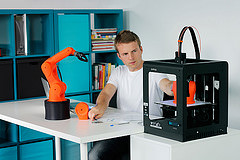

Photo by Creative Tools
is licensed under CC BY 2.0
Occasionally, technology astounds us. 3D printing does that for me.
It’s like something out of a science fiction movie – a futuristic technology that everyone knows is not really possible. After visiting a 3D Printing Museum in New York, I came away marveling at what I had seen and wondering how it could be possible for a machine to print – literally print and produce – a vase, a chair, a toy, a piece of jewelry or something even more unimaginable.
I could write about the fear Amazon must have about the value of “same day delivery” when people in the future will likely just print products they want to purchase. And, after listening to researchers talk about 3D technology that will print, or produce, body parts, I could only speculate about the unbelievable changes we will experience in the near future. But, this article is about how 3D technology is changing the world of construction.
In Amsterdam, a company that develops groundbreaking robotic 3D print technology is planning to produce the world’s first 3D-printed steel bridge. Here’s a bit about how it will happen. A 3D graphic representation that outlines the depth, breadth and height of the project will be created. This begins when a 3D scanner makes a 3D digital copy of the physical components of the bridge. Then the digital copy is used to make every component required for the bridge.
This first-of-its-kind bridge will be made of stainless steel. It will be a pedestrian bridge over a canal. Industrial robots and a welding machine will be the key components of construction. Software will drive both. While most structures using a 3D print model have used concrete in the past, this printer will use beads of molten steel that are stacked and dried to form structures in mid-air.
Robots will construct the bridge, and because of that, no supporting structures will be required. The robots will build their own support structures as the construction progresses. Although this will be the first 3D-printed steel bridge project ever, use of 3D technology in construction is not new. Transportation agencies plan and design today with 3D technology. It’s the printing or production part of 3D technology that is new.
Architects and contractors throughout the world are beginning to build 3D residential structures. In China, one firm produced the world’s first 3D-constructed, five-story apartment building. The same company claims to have built 10 3D-constructed homes in a one-day period of time at a cost of only $5,000 per house! There are reports of construction time being reduced by 50-70 percent and labor costs by 50-80 percent when 3D technology is used.
A 20-foot-tall 3D printer will be located at the construction site of what will soon be the world’s first 3D constructed office building in Dubai. The United Arab Emirates National Innovation Committee will work with private companies to make all the construction components on-site rather than fabricate the pieces off-site and then transport them. Construction should take only a few weeks.
The United States may be a little “behind the curve” when it comes to 3D printing, but 3D technology is being used on all types of construction projects. The Federal Highway Administration says that Wisconsin’s Department of Transportation is one of the country’s leaders in the use of 3D technology. In Oregon, a $295 million project to build a new Collaborative Life Sciences Building has proven to be more than successful. At least $10 million in cost reductions was realized as a result of an all-digital documentation process. In California, a fabrication process that allows contour crafting is being developed. This process would allow gigantic 3D printers to produce a whole house in a single run and the 3D printed house would include electrical and plumbing conduits.
It is a new world! 3D printing technology is rushing toward us with ferocious speed. Construction is only one of the industries that will be significantly impacted in the next few years.
